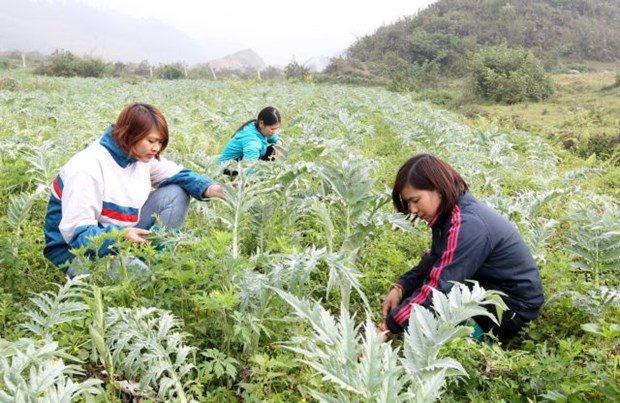Lao Cai sets sights on boosting medicinal herb sector
The mountainous northern province of Lao Cai hopes to almost double its medicinal herb growing area in the next 10 years, expecting to achieve a yearly output of more than 11,000 tonnes.
 Farmers tend to artichoke plants in the rural district Bac Ha, Lao Cai province (Photo: VNA)
Farmers tend to artichoke plants in the rural district Bac Ha, Lao Cai province (Photo: VNA)Lao Cai (VNA) - The mountainous northern province of Lao Cai hopes to almost double its medicinal herb growing area in the next 10 years, expecting to achieve a yearly output of more than 11,000 tonnes.
Director of the Lao Cai Department of Agriculture and Rural Development Nguyen Anh Tuan said the province hopes to have about 3,500ha of medicinal herbs by 2030, concentrating on 22 key plants.
The medicinal herb growing areas will be mostly in the districts of Sa Pa, Bac Ha, Bat Xat, Si Ma Cai, Muong Khuong and Van Ban.
By the end of last year, the province had more than 1,800 ha of medicinal herbs, up 21 percent compared to the previous year. Last year, medicinal herb productivity in the province hit nearly 8,300 tonnes. On average, local growers earned 124-240 million VND per hectare, while some earned more than 600 million VND per ha.
Duong quy (female ginseng), xuyen khung (Szechuan lovage), cat canh (balloon flower), tam that (Himalayan ginseng) and artichoke are among key medicinal herbs the province hopes to develop. The authority had offered technical and financial support to boost links between production and consumption of the herbs since last year, Tuan said.
This year, the province will continue shifting corn-growing areas and part of planted forest land to medicinal herbs, Tuan said, adding that the province wants to grow more medicinal herbs under the forest canopy to better protect forest resources and create a livelihood for the community.
The province also wants to boost cooperation among herb growers, companies and research institutes in medicinal herb production and consumption, he said.
The agriculture department has asked districts to identify areas and medicinal herbs to grow as well as pay more attention to developing medicinal herb farms under the forest canopy and apply the WHO’s guidelines on good agricultural and collection practices (GACP-WHO).
The Ministry of Health has so far certified four medicinal herbs of Lao Cai to GACP-WHO standards, including artichoke grown in Sa Pa district, che day (a type of vine native to many Asian countries) in Sa Pa and Bat Xat, Duong quy in Bac Ha district and xuyen khung in Bat Xat.
At least 10 companies, co-operatives and individuals in the province have production-consumption linkages, helping them trade more than 3,000 tonnes of herbs yearly.
The links help form areas that specialise in growing medicinal herbs, boosting the application of advanced technology to increase productivity and product quality.
Lao Cai also plans to develop branding and cataloguing. Growers and traders will be instructed to register barcodes to ensure origin traceability, Tuan said.
Lao Cai wants to promote local medicinal herbs as its typical products, aiming that each commune will have a special product, he said.
Nguyen Tien Hong, deputy head of the Bac Ha district Agriculture sub-department said that this year, 105 ha of land in the district was used to grow medicinal herbs, mostly Duong quy and cat canh.
Local authorities have provided technical and financial assistance for 38ha while the remaining 67ha of medicinal herbs were grown by companies or families, he said.
With favourable weather, soil and proper nursing, Duong quy had done well in the mountainous area, Hong said, adding that the herb helped growers earns as much as 3-4 times more than if they grew corn or rice.
In Lung Phinh – one of eight communes planned to develop medicine herbs growing zone in the district, people could earn 80-200 million VND from 1ha of medicinal herbs.
Many families have escaped poverty and become prosperous thanks to medicinal herbs, Hong said./.













